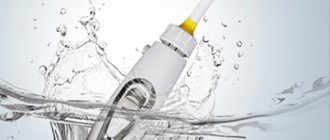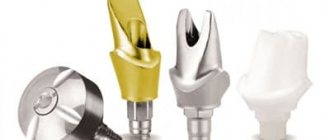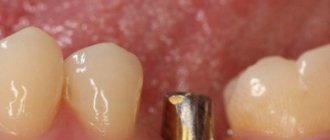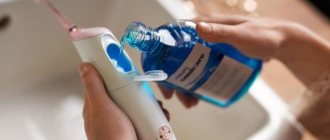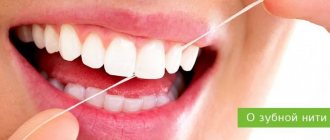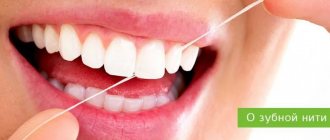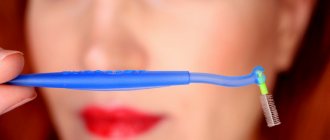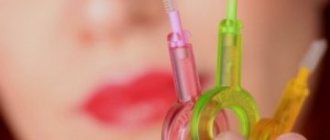Brushing your teeth after installing braces becomes more difficult. Residues of food stuck between parts of the structure cannot be removed by brushing, flossing or rinsing. This problem can be solved through daily use of an irrigator. We'll tell you which device is better to choose and how to use it when caring for braces.
In this article
- What types of irrigators are there?
- Irrigators for braces: orthodontic attachments
- Irrigator for braces - how to choose
- Rating of the best irrigators for caring for braces
- How to use a irrigator to clean braces
Braces are complex metal structures consisting of many small parts. They are placed on teeth to change their position. These orthodontic devices are non-removable. They cannot be removed before going to bed or after eating to clean and rinse. Oral care becomes more difficult. However, neglecting hygiene is dangerous. There is a risk that plaque will begin to form under the braces or carious lesions will appear. A large amount of food accumulates behind the structural elements, which cannot be removed with a regular brush. Special brushes and threads allow you to cope with this problem, but they take a lot of time. It is much faster to get your braces in order by cleaning them from food debris with an irrigator.
Oral cleaning devices are available with various attachments: standard, tongue, massage, periodontal and orthodontic. Let's try to figure out which irrigator is best to use for braces. First, let's talk about the main features of these devices.
Irrigator - a device for cleaning teeth and gums
First, let's figure out what this personal hygiene item is. The irrigator resembles an electric toothbrush with a thin tip instead of bristles. This device operates on the principle of a hydraulic compressor. Pressure is created inside the device, pushing water through the tip under high pressure. The flow of liquid washes away plaque and food particles from the teeth, cheeks, gums and tongue, thereby preventing the development of numerous dental diseases. Some experts do not recommend using the device for patients with problem gums, fearing that it may worsen the situation. However, modern devices, as a rule, have a built-in massage mode that strengthens soft tissues and improves their condition. However, people with acute inflammation should not use the device for some time.
The unique, multifunctional device JETPIK JP200 Elite combines an electric sonic toothbrush, irrigator and dental floss. The components and the device itself are stored in a convenient plastic container, which is ideal for traveling or storing in a small bathroom.
When not to use
Doctors recommend using a jet applied to the teeth under pressure as part of a comprehensive cleaning, rather than in isolation. This hygienic procedure is useful for people with braces, bridges, crowns, and periodontal diseases.
There are restrictions on the use of the described equipment. Thus, in case of severe diseases of the cardiovascular system, acute periodontitis and gingivitis, during the recovery period after surgery on oral tissues, you cannot experiment with dental innovations.
If you have any doubts about whether to purchase equipment, you should consult your dentist. The doctor will tell you what to do right.
Why do you need an irrigator?
Why do you need an oral irrigator? Firstly, it copes with tasks that many toothbrushes cannot do: it removes plaque not only from the surface of the teeth, but also from hard-to-reach places: interdental spaces, as well as areas between the tooth and the gum. The accumulation of deposits in these areas that are impenetrable to brushing leads to such common diseases as cervical caries, diseases of the periodontal tissues - gingivitis and periodontitis, as well as caries of contact surfaces. Secondly, an irrigator is necessary for owners of braces, dentures, crowns, veneers, lumineers and implants. Such orthopedic or orthodontic structures make oral hygiene difficult and require special care. And finally, thirdly, the stream of water coming out of the irrigator cleans out periodontal pockets and also massages the gums, which helps strengthen them and, as a result, reduce bleeding.
Attachments for cleaning bracket systems
The following types of attachments are suitable for effective cleaning of braces:
- Orthodontic attachment OD-100E. Designed for thorough and gentle cleaning of braces and other orthodontic systems. Delivers a thin stream of water for spot treatment of all elements. Removes food particles and soft plaque well, recommended for everyday individual use.
- Nozzle for removing plaque PS-100E. Equipped with three tufts of soft bristles that thoroughly remove bacterial deposits and wash them away. To increase cleaning efficiency, when using the nozzle, you need to use movements like when brushing with a toothbrush. Regular use of the nozzle allows you to remove plaque from teeth and gums and clean orthodontic and orthopedic structures.
- Periodontal tips PP-100E and PP-70E. Designed to care for deep gum pockets, but no less effective when cleaning braces. Allows you to effectively clean even hard-to-reach places.
Nozzles must be changed every 3 months.
Which irrigator to buy for braces:
- Waterpik WP-100 E2 Ultra, WP-108 E2 Ultra Gold, WP-112 E2 Ultra Black.
- Waterpik WP-300 E2 Traveler.
- Waterpik WP-450 E2 Cordless Plus, WP-462 E2 Cordless Plus Black, WP-560 EU Cordless Advanced.
- Waterpik WP-660 E2 Ultra Professional, WP-672 E2 Ultra Professional Designer Series.
- Waterpik WP-260 E2 For kids.
According to reviews from dentists and buyers, the leaders are stationary models with a large reservoir for medical solutions, in particular, Waterpik WP-100 E2 Ultra. Stationary irrigators come with up to 7 attachments, including a special attachment for caring for orthodontic systems.
Varieties
Today there are a large number of irrigators, differing from each other in various parameters. Devices are divided into portable and stationary, powerful and not very powerful, with one or more nozzles and modes, with and without microbubble technology, with a water tank and with a connection to a tap, as well as with built-in dental floss, like JETPIK irrigators, in several times increasing the effectiveness of teeth cleaning. Do not also forget that each device has a certain warranty period, depending on the policy of the manufacturer. Read about how to choose the best irrigator in our other articles.
Reliable and convenient irrigator for the whole family Hydro Floss Kitty Waterjet
How to use an irrigator correctly
At first, it is recommended to set the device to the weakest setting so as not to damage soft tissues and cause pain. During cleaning, the handle of the device should be held at an angle of 90° to the surface of the teeth. You should tilt your head so that the liquid will immediately flow into the sink. How often you need to use an oral irrigator, the number of daily procedures and their duration depend on the individual characteristics of the owner of the device. For some, it will be enough to use the irrigator no more than 3 - 4 times a week for 5 minutes daily, while for others, for example, those who wear braces, crowns, implants or other structures or suffer from crowded teeth, to achieve the desired result, you should wash your teeth at least twice a day for 10-15 minutes. In any case, the plan for using the irrigator must be approved by a specialist.
By the way, some devices have a sensor installed that helps to organize the cleaning process correctly. Based on the time given to him, he independently plans the course of the procedure and “informs” his owner when he needs to move from the treated area of the oral cavity to the untouched one.
The Panasonic Dentacare Handy EW 1211 portable irrigator is one of the best devices in terms of reliability.
What is this?
An irrigator is a fairly simple device for cleaning teeth. It delivers a stream of water or a special dental solution under pressure. As a result, all hard-to-reach areas of the mouth are very quickly cleared of food accumulations and soft plaque.
It is especially important to purchase a device for the mouth for people who use mouth guards, wear braces, plates, have a dental bridge, crowns, or implants. It is indispensable when it comes to washing out food debris from under orthodontic systems. At the same time, it massages the gums and increases local blood circulation.
There are several attachments for convenient use. Your doctor will tell you how to choose the right one to solve specific problems.
How often should you use a waterpik?
Experts differ in answer to this simple question. The only thing that dentists are unanimous about is that it all depends on the condition of the oral cavity and for what purpose you are going to use the irrigator - preventatively or as part of complex therapy.
For healthy teeth
If you take care of your teeth and do not neglect daily personal hygiene, then it is enough to use the irrigator once a day for 4 days a week - solely for the purpose of preventing the formation of tartar in hard-to-reach places.
For people with bad habits
For heavy smokers, as well as those who like to abuse black coffee, tea or red wine, who are prone to the formation of dense plaque, dentists recommend using an irrigator 2 times a day every day as the final stage of oral hygiene.
During pregnancy
Women expecting a baby are extremely susceptible to any infection. Therefore, to prevent the activation of bacteria that cause caries, an irrigator is indispensable at least once a day.
For gum diseases
If you have chronic inflammatory gum diseases, such as periodontitis or gingivitis, the frequency of use of the irrigator, especially a special periodontal attachment, should be regulated by the periodontist who is observing you.
When wearing braces
Modern brace systems, despite their dramatic progress compared to the designs of 20 years ago, require increased hygiene. In this situation, it is advisable to use an irrigator after each meal during the day.
If you have dentures
The situation is similar with any removable dental prostheses: the more often and thoroughly their hygiene is carried out using an irrigator, the better and longer they will last.
Attention!
After undergoing surgical interventions in the oral cavity, the use of an irrigator should be abandoned until the time when the attending physician allows it.
Types of equipment for cleaning technology
If we classify devices according to sedum technology, they are:
- With a pulsating jet. Allows you to get a very thin stream with a short pulsation. During their operation, a microhydraulic shock mode is created, thanks to which soft plaque is quickly removed. Pulsation is ideal for people prone to periodontitis and gingivitis.
- Microbubbles. Considered the most effective. During operation, air and liquid are mixed. Oxygenated water cleans crowns better. The microbubble system is optimal if the patient often has inflamed gums, has crowns, or implants. It can even be used to rinse the nasal passages and oropharynx, which is important for people suffering from chronic rhinitis and pharyngitis.
- With mono jet. They are arranged quite simply. Essentially, these are adapters between a water tap and a person’s mouth. The products do not allow the use of antibacterial medicinal compounds or filtered water, as they are connected directly to the tap. But some of them are equipped with a capsule into which you can additionally add antibacterial liquid. Monojet techniques are suitable for the prevention of various dental diseases. Its main advantage is its affordable price. But in terms of the effectiveness of enamel cleansing, it is significantly inferior to the first two options.
Rules for caring for the device
The irrigator, like all electrical appliances, requires special care. The device should be washed as follows: firstly, do not under any circumstances immerse the entire irrigator in water, especially when it is turned on - it may short out (which is deadly!), and its parts may rust. Secondly, do not use unboiled water to clean the device, only filtered and, preferably, warm water. Otherwise, scale will form inside the mechanism, which will lead to its breakdown. In order to thoroughly clean the irrigator, you need to fill it exactly halfway with warm water, empty the reservoir after a couple of minutes, rinse the device and nozzles for the irrigator, and then wipe all components dry. Particularly advanced manufacturers produce devices together with a UV sanitizer designed to disinfect replaceable attachments. The ultraviolet radiation on which it works destroys microbes accumulated on the tips and thus prevents the development of dental diseases. As for the storage conditions of the irrigator, it should be kept in a dry place. Touching the appliance plug with wet hands is strictly prohibited.
In principle, the irrigator should not be cleaned too often, except for those cases when you pour special decoctions into its tank. Particles of herbs from the infusion remain inside the device and may damage its operation.
Multifunctional irrigator OR 820M Donfeel with nasal attachment
How to choose a liquid for an irrigator?
When using the irrigator, special attention should be paid to the cleaning agent. Usually, irrigators come with a special balm that should be added to the water in the tank. The type of balm and the level of its concentration in water will depend on the condition of the oral cavity and the presence of certain dental problems. Some people pour regular rinse aids into the tank, but they foam quite a lot and make the cleaning process difficult. You can also use ordinary water as a cleaning agent, but only filtered water - it is safer and does not contain impurities that settle inside the device and interfere with its operation. Remember: if there is no water in the container, the irrigator cannot be turned on.
It is important to remember that it is not enough to buy an irrigator and think that it will save you from using conventional hygiene products! The device will provide a final cleaning of your teeth, removing what the toothbrush couldn’t handle. And the supplement will improve blood circulation, stimulate the renewal of soft tissues, prevent the formation of tartar and eliminate bad breath. Our Irrigator Rating 2022 will help you choose the right model.
The importance of the number of attachments
The irrigator usually comes with several attachments. Stationary models most often come with a larger number of tips - from 4 to 10 pieces, portable ones - from 1 to 4. As a rule, replacement tips for irrigators are different: for orthopedic and orthodontic structures, for cleaning periodontal pockets, interdental spaces and tongue, as well as tips in the form of mono-beam and regular brushes. Any nozzle can be purchased in addition, although their cost individually may be somewhat inflated, so we recommend purchasing devices with a complete set, where a separate tip is provided for each family member. JETPIK JP200-Ultra is considered one of the most complete irrigators. The set includes three standard nozzles, two brush nozzles, a tongue cleaner, 10 floss cartridges, a hose clip and a glass with a water supply function, a UV sanitizer, a charger and a compact box for transporting the device.
A very powerful device with a wide range of equipment and stylish design
.
Irrigators also come with different levels of vibration and noise (alas, absolutely silent models have not yet been invented), as well as all kinds of shapes, colors and sizes. Which one you prefer is up to you to decide.
